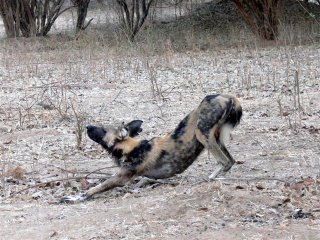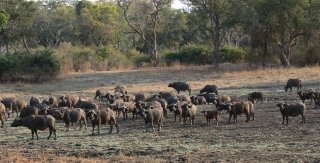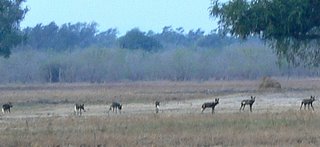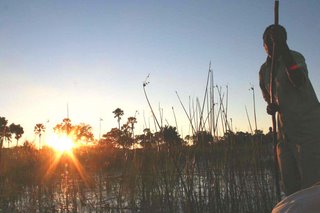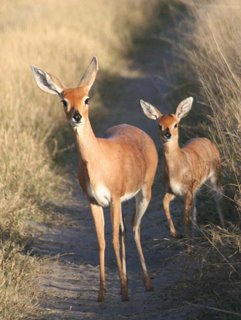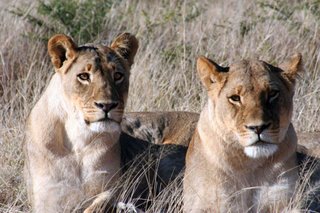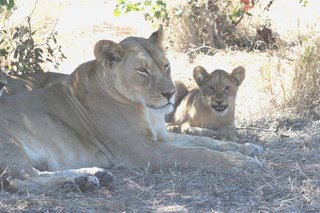Coopers’ Company and Coborn School visit Namibia, Botswana and Zambia, and Twabuka Community School officially opens.
On 4th August 2006 Twabuka Community School was officially handed over to the Ministry of Education in Livingstone so that it could become a recognised school, and on 4th September the new school term started.
The opening ceremony was quite an event. In true Zambian style the proceedings started over an hour late. In England everybody would have been checking their watches impatiently, and pacing up and down, but out here everybody was taking it in their stride, using the opportunity to shake hands, chat and enjoy the chance to relax a bit.
The formal element of the proceedings involved speeches by representatives of the ministry, Alan and Oriel from Nomad African Travel and staff and students from Coopers’ School. There was also a moving poem of thanks from three of the village children who will benefit from the new school. The highlight of the day came with the entertainment - the village women danced and sang, accompanied by drums and whistles. Then the children danced and one dance of particular note was performed by a young boy whose replica of a traditional costume had been crafted, in true ‘Blue Peter’ style from cardboard boxes and empty cement sacks. In return, the students from Coopers’ also sang.


Students outside Twabuka Community School and at the official opening
Over the last 2 years students from Coopers’ had been very busy fundraising for the purchase of materials to enable the school to be built. The finances had been further boosted by donations from Nomad clients and friends. At one time the spiralling value of the Zambian Kwacha looked as if it would leave us short of money, but the huge generosity of all concerned meant we did not fall short. Alan and Oriel have been the project managers, managing the finances, the drilling of the borehole, the building site, and ensuring regular supplies of materials and food for the workers. Many trips to the site have taken place over the last two years to realise this project.
The opening ceremony came at the end of an exciting and eventful trip for the students from England. On 11th July, 30 students and 3 staff had left to fly to Namibia, where they were met at Windhoek airport by Alan and Oriel of Nomad. Our convoy of 5 landrovers and two trailers provided transport for a 14 day trip of a lifetime for the students. Starting at Waterberg Plateau, the students experienced wilderness camping on top of this remote plateau, and tracking black and white rhino on foot. The Parks Board managers on site also took them around the capture centre, where numerous rhino and buffalo were held before relocation - evidence of the successful breeding programme on the plateau.


Travelling along the sand roads on top of Waterberg Plateau and rhino at the holding centre
Our next stop was Etosha National park. Here the group experienced lion at extremely close quarters when, on one of our game drives, three lions were spotted just emerging from the tree line, making for the open plain. By positioning the vehicles carefully we predicted the place where they would cross the road and, sure enough, one of the fantastic males strode confidently by, the wind blowing through his mane, so close that his huge paws and powerful muscles could all be appreciated in great detail.


Giraffe and lion in Etosha National Park
From Etosha the group stopped off at Popa Falls and once we entered northern Namibia the students started to realise the basic level of accommodation in which so many of Africa’s people live. Many were truly surprised that this is the norm rather than the exception, and they started to really understand that the value of their fund raising was more than just financial.
Our next stop was Maun in Botswana, the base for an onward trip to the edge of the Okavango Delta. Leaving our landrovers, everyone had great fun loading the trailer with bags and provisions and piling into a huge open truck. The transport for the next two days was to be dug out canoe and foot. This was true camping, with an open fire to cook on, no facilities, water fetched from the Delta, and wild animals all around. Hippo were at close quarters during one of the canoe trips and everyone had a great time getting absolutely filthy.

Travelling by dug out canoe in the Okavango Delta
The last stop in Botswana was Chobe National Park. Here the highlight was probably the elephant which, by this time of year, were in huge numbers along the river section of the park. A boat trip on the Chobe led to close sightings of crocodile and more hippo and many students had, by this time, also developed an appreciation of the widely varied birdlife.


Cooking breakfast after an early morning game drive in Chobe National Park and hippo by the Chobe River
The last stop was Livingstone where, for 13 nights, students made Liyoyelo Farm their home. Each day some of the students travelled up to the school to undertake painting and decorating of both exterior and interior. Others organised supplies of materials and equipment from town, and the remaining group stayed at the farm to become the carpentry group – their task was to make tables and chairs for the school. Alan had a particularly important role as purchaser of chocolate rations in order to keep energy levels and spirits high!

Students start painting the inside of the classrooms
Along with tools and equipment, students had filled much of their luggage allowance with things for the school and also football boots and kit. Our Nomad sponsored team Bushmad enjoyed a good victory over the student side, though playing on a hard earth pitch in high temperatures led to frequent substitutions. It was the first time that the Bushmad team had played a side including women, and even Alan came out of retirement to play a pivotal role in defence. By the end of the game there were many injuries, but the team had to rally themselves again the next day, for a match against Sindie village. This was also tough going but nothing compared to the unexpected challenge to a netball game. It soon became apparent that women who carry 25kg of mealie maize on their heads, plus at least one baby on their back, have immeasurable strength and determination when it comes to winning a game of netball. Plasters and antiseptic cream were yet again much in demand by the end of the day. The crowds were fantastic at these games, providing further entertainment in the form of singing and dancing - these were not events put on for tourist, but an opportunity to really engage with the local community.


The football team at Liyoyelo Farm and the game against Bushmad
A last finale for the local children was a trip to Victoria Falls. Although they had lived all their lives just 16km from the falls none of them had visited before. The students from England teamed up with two or three children each and provided a memorable day out for all concerned.


Students from Coopers’ School and pupils of Twabuka Community School at Victoria Falls
In addition the students made the most of all the activities on offer in Livingstone on their final day. Activities included helicoptor, Tiger Moth and microlight flights over the falls, canoeing and fishing on the Zambezi and an adrenaline rush Jet Boat trip.
When we returned from our last evening meal out we discovered that in our absence the elephants had paid a visit to the farm. The mango trees had been stripped and flower beds had been eaten. In order to eat our tomato plants the large bulls had torn out metal fence panels and stepped carefully over the remaining block walls. This wall surrounded the vegetable garden where students had pitched their tents, the huge foot prints were within inches of the tents but there was no damage to them, the elephant had taken great care to step around the tents in order to eat the tasty offerings and depart before we returned. On the morning of the students departure the breeding herd of elephant also made a visit, they were very close to the back of the house and it was as though they had turned up to give the students one last powerful memory of Africa. As they demolished the trees everybody quietly watched from just a few feet away.

The last morning at Liyoyelo Farm, elephants arrive for a close encounter at the back of the house
By the time the students had decorated the school and made the furniture, it had been transformed. The importance of wildlife to the Zambian tourist economy and the tremendous enjoyment that the students had experienced from their game viewing was in evidence, with the walls not only decorated with numbers and letters, but with animals and birds in abundance. It is our hope that the children and people of Sindie village will in future not just view elephants as a threat and a crop raider, but will truly appreciate that, through tourism, it was those same elephants that brought their new school to them. It is difficult to support wildlife when your years supply of mealie maize had just been devoured in one evening, but over time advantages as well as disadvantages can result from these giant lawnmowers.




Scenes of wildlife decorating the walls of the classrooms
Just over a month on from the opening everybody is enjoying the school, but we know that the fundraising will not stop as the school opens. We would like to provide a meal for every child every day and Julian and Jonquil Bond, who visited Livingstone recently, have volunteered to fund raise in order to realise this by building a kitchen and dining area.
Ongoing expenditure will include teachers wages, appointment of a second teacher in January, cleaning materials, and wages for the night guard and caretaker/cleaner.
There are books to buy and the school have requested a radio so they can listen to the educational broadcasts that are available. At a later date we might aspire to solar power so that we could run a television with video player and possibly even a few computers. Other things on the wish list include landscaping the grounds, planting trees to provide some shade, a library for general village use and education, a teachers house and teachers toilets.
Sometimes small things are powerful symbols and there are two examples of these at Twabuka - outside the school the students from Coopers’ school cordoned off some pathways with stones that they and the children had collected from the surrounding area. Some of the leftover paint was used to paint a few of these stones pink and these pink stones were arranged just in front of the school entrance in the shape of a heart, symbolising the fact that this school has been enabled and given to the community with love from many people. Just inside the door is a tree, whose leaves are made from the hand prints of all the staff and students and staff from Coopers’. Alan and Oriel were honoured to be the first to stick their hands in the paint and slap them onto the wall, to leave their personal mark amongst those of the many students who worked so hard on the project.

The front entrance to the school, built and given with love
Coopers’ School created a web site for their tour, which was updated as the trip progressed. It also has a selection of photographs. If you would like to enjoy it please go to www.intoafrica2006.co.uk. In particular you might wish to visit the messages home page and the trip photographs page.
Should you wish to support Twabuka Community School please contact Alan or Oriel, their e-mail address in Zambia is nomad@microlink.zm
The opening ceremony was quite an event. In true Zambian style the proceedings started over an hour late. In England everybody would have been checking their watches impatiently, and pacing up and down, but out here everybody was taking it in their stride, using the opportunity to shake hands, chat and enjoy the chance to relax a bit.
The formal element of the proceedings involved speeches by representatives of the ministry, Alan and Oriel from Nomad African Travel and staff and students from Coopers’ School. There was also a moving poem of thanks from three of the village children who will benefit from the new school. The highlight of the day came with the entertainment - the village women danced and sang, accompanied by drums and whistles. Then the children danced and one dance of particular note was performed by a young boy whose replica of a traditional costume had been crafted, in true ‘Blue Peter’ style from cardboard boxes and empty cement sacks. In return, the students from Coopers’ also sang.


Students outside Twabuka Community School and at the official opening
Over the last 2 years students from Coopers’ had been very busy fundraising for the purchase of materials to enable the school to be built. The finances had been further boosted by donations from Nomad clients and friends. At one time the spiralling value of the Zambian Kwacha looked as if it would leave us short of money, but the huge generosity of all concerned meant we did not fall short. Alan and Oriel have been the project managers, managing the finances, the drilling of the borehole, the building site, and ensuring regular supplies of materials and food for the workers. Many trips to the site have taken place over the last two years to realise this project.
The opening ceremony came at the end of an exciting and eventful trip for the students from England. On 11th July, 30 students and 3 staff had left to fly to Namibia, where they were met at Windhoek airport by Alan and Oriel of Nomad. Our convoy of 5 landrovers and two trailers provided transport for a 14 day trip of a lifetime for the students. Starting at Waterberg Plateau, the students experienced wilderness camping on top of this remote plateau, and tracking black and white rhino on foot. The Parks Board managers on site also took them around the capture centre, where numerous rhino and buffalo were held before relocation - evidence of the successful breeding programme on the plateau.


Travelling along the sand roads on top of Waterberg Plateau and rhino at the holding centre
Our next stop was Etosha National park. Here the group experienced lion at extremely close quarters when, on one of our game drives, three lions were spotted just emerging from the tree line, making for the open plain. By positioning the vehicles carefully we predicted the place where they would cross the road and, sure enough, one of the fantastic males strode confidently by, the wind blowing through his mane, so close that his huge paws and powerful muscles could all be appreciated in great detail.


Giraffe and lion in Etosha National Park
From Etosha the group stopped off at Popa Falls and once we entered northern Namibia the students started to realise the basic level of accommodation in which so many of Africa’s people live. Many were truly surprised that this is the norm rather than the exception, and they started to really understand that the value of their fund raising was more than just financial.
Our next stop was Maun in Botswana, the base for an onward trip to the edge of the Okavango Delta. Leaving our landrovers, everyone had great fun loading the trailer with bags and provisions and piling into a huge open truck. The transport for the next two days was to be dug out canoe and foot. This was true camping, with an open fire to cook on, no facilities, water fetched from the Delta, and wild animals all around. Hippo were at close quarters during one of the canoe trips and everyone had a great time getting absolutely filthy.

Travelling by dug out canoe in the Okavango Delta
The last stop in Botswana was Chobe National Park. Here the highlight was probably the elephant which, by this time of year, were in huge numbers along the river section of the park. A boat trip on the Chobe led to close sightings of crocodile and more hippo and many students had, by this time, also developed an appreciation of the widely varied birdlife.


Cooking breakfast after an early morning game drive in Chobe National Park and hippo by the Chobe River
The last stop was Livingstone where, for 13 nights, students made Liyoyelo Farm their home. Each day some of the students travelled up to the school to undertake painting and decorating of both exterior and interior. Others organised supplies of materials and equipment from town, and the remaining group stayed at the farm to become the carpentry group – their task was to make tables and chairs for the school. Alan had a particularly important role as purchaser of chocolate rations in order to keep energy levels and spirits high!

Students start painting the inside of the classrooms
Along with tools and equipment, students had filled much of their luggage allowance with things for the school and also football boots and kit. Our Nomad sponsored team Bushmad enjoyed a good victory over the student side, though playing on a hard earth pitch in high temperatures led to frequent substitutions. It was the first time that the Bushmad team had played a side including women, and even Alan came out of retirement to play a pivotal role in defence. By the end of the game there were many injuries, but the team had to rally themselves again the next day, for a match against Sindie village. This was also tough going but nothing compared to the unexpected challenge to a netball game. It soon became apparent that women who carry 25kg of mealie maize on their heads, plus at least one baby on their back, have immeasurable strength and determination when it comes to winning a game of netball. Plasters and antiseptic cream were yet again much in demand by the end of the day. The crowds were fantastic at these games, providing further entertainment in the form of singing and dancing - these were not events put on for tourist, but an opportunity to really engage with the local community.


The football team at Liyoyelo Farm and the game against Bushmad
A last finale for the local children was a trip to Victoria Falls. Although they had lived all their lives just 16km from the falls none of them had visited before. The students from England teamed up with two or three children each and provided a memorable day out for all concerned.


Students from Coopers’ School and pupils of Twabuka Community School at Victoria Falls
In addition the students made the most of all the activities on offer in Livingstone on their final day. Activities included helicoptor, Tiger Moth and microlight flights over the falls, canoeing and fishing on the Zambezi and an adrenaline rush Jet Boat trip.
When we returned from our last evening meal out we discovered that in our absence the elephants had paid a visit to the farm. The mango trees had been stripped and flower beds had been eaten. In order to eat our tomato plants the large bulls had torn out metal fence panels and stepped carefully over the remaining block walls. This wall surrounded the vegetable garden where students had pitched their tents, the huge foot prints were within inches of the tents but there was no damage to them, the elephant had taken great care to step around the tents in order to eat the tasty offerings and depart before we returned. On the morning of the students departure the breeding herd of elephant also made a visit, they were very close to the back of the house and it was as though they had turned up to give the students one last powerful memory of Africa. As they demolished the trees everybody quietly watched from just a few feet away.

The last morning at Liyoyelo Farm, elephants arrive for a close encounter at the back of the house
By the time the students had decorated the school and made the furniture, it had been transformed. The importance of wildlife to the Zambian tourist economy and the tremendous enjoyment that the students had experienced from their game viewing was in evidence, with the walls not only decorated with numbers and letters, but with animals and birds in abundance. It is our hope that the children and people of Sindie village will in future not just view elephants as a threat and a crop raider, but will truly appreciate that, through tourism, it was those same elephants that brought their new school to them. It is difficult to support wildlife when your years supply of mealie maize had just been devoured in one evening, but over time advantages as well as disadvantages can result from these giant lawnmowers.




Scenes of wildlife decorating the walls of the classrooms
Just over a month on from the opening everybody is enjoying the school, but we know that the fundraising will not stop as the school opens. We would like to provide a meal for every child every day and Julian and Jonquil Bond, who visited Livingstone recently, have volunteered to fund raise in order to realise this by building a kitchen and dining area.
Ongoing expenditure will include teachers wages, appointment of a second teacher in January, cleaning materials, and wages for the night guard and caretaker/cleaner.
There are books to buy and the school have requested a radio so they can listen to the educational broadcasts that are available. At a later date we might aspire to solar power so that we could run a television with video player and possibly even a few computers. Other things on the wish list include landscaping the grounds, planting trees to provide some shade, a library for general village use and education, a teachers house and teachers toilets.
Sometimes small things are powerful symbols and there are two examples of these at Twabuka - outside the school the students from Coopers’ school cordoned off some pathways with stones that they and the children had collected from the surrounding area. Some of the leftover paint was used to paint a few of these stones pink and these pink stones were arranged just in front of the school entrance in the shape of a heart, symbolising the fact that this school has been enabled and given to the community with love from many people. Just inside the door is a tree, whose leaves are made from the hand prints of all the staff and students and staff from Coopers’. Alan and Oriel were honoured to be the first to stick their hands in the paint and slap them onto the wall, to leave their personal mark amongst those of the many students who worked so hard on the project.

The front entrance to the school, built and given with love
Coopers’ School created a web site for their tour, which was updated as the trip progressed. It also has a selection of photographs. If you would like to enjoy it please go to www.intoafrica2006.co.uk. In particular you might wish to visit the messages home page and the trip photographs page.
Should you wish to support Twabuka Community School please contact Alan or Oriel, their e-mail address in Zambia is nomad@microlink.zm
 Nomad: Africa Diary
Nomad: Africa Diary
